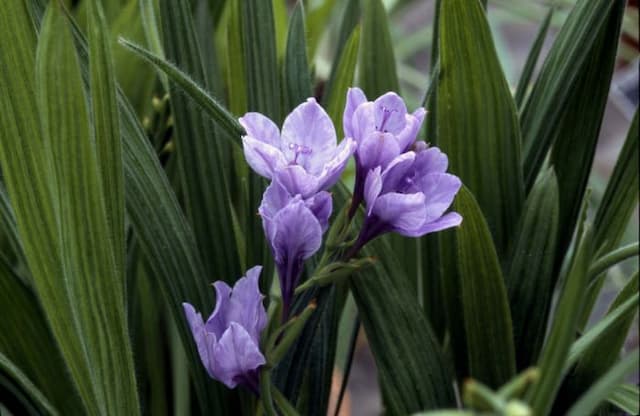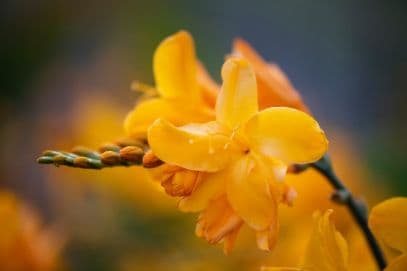Japanese iris Iris japonica

ABOUT
Iris japonica, commonly known as the fringed iris, is a captivating plant renowned for its unique and ornate flowers. The blooms of this species feature delicate, light blue to lavender petals, which are adorned with a distinctive fringe along the edges, giving it a frilly appearance that is uncommon among other iris relatives. The most striking part of the fringed iris's flower is the bright yellow or white pattern, resembling a crest or signal patch, that resides on the falls—the downward-hanging petal of the iris. This contrasting pattern serves to attract pollinators. The fringed iris's foliage forms a neat clump of long, slender leaves that are sword-like in shape, creating an attractive, grassy tuft even when the plant is not in bloom. The leaves are bright to mid-green and can have a slightly glossy texture, adding a lush visual presence to the garden setting. In bloom, the flowers rise above this foliage on slender, branched stalks, with each stalk potentially bearing multiple flowers. With its striking appearance, fringed iris offers a touch of elegance and charm to any garden space, particularly excelling in areas where the intricate detail of its blooms can be appreciated up close. The plant is often used in borders, rock gardens, and alongside streams or ponds where its pleasing appearance can be showcased effectively.
About this plant
 Names
NamesSynonyms
Fringed Iris, Shaga, Butterfly Flower, Japanese Iris
Common names
Iris japonica Thunb., Evallagheria japonica (Thunb.) Klatt
 Toxicity
ToxicityTo humans
Iris japonica, commonly known as Fringed Iris, is not typically listed as a highly toxic plant to humans. However, ingesting parts of this plant can cause irritation to the digestive tract due to its saponins content. If parts of the Fringed Iris are ingested, symptoms may include nausea, vomiting, abdominal pain, and diarrhea.
To pets
Fringed Iris can be toxic to pets if ingested. The plant contains irisin, irisine, and other harmful compounds such as saponins that can cause gastrointestinal irritation. Symptoms of poisoning in pets may include drooling, vomiting, diarrhea, lethargy, and in severe cases, could lead to gastrointestinal upset or dermatitis. Pet owners should keep Fringed Iris out of reach and contact a veterinarian if they suspect ingestion.
 Characteristics
CharacteristicsLife cycle
Perennials
Foliage type
Evergreen
Color of leaves
Green
Flower color
Purple
Height
1-2 feet (0.3-0.6 meters)
Spread
1-2 feet (0.3-0.6 meters)
Plant type
Herb
Hardiness zones
6-9
Native area
China, Japan
Benefits
 General Benefits
General Benefits- Ornamental Value: Iris japonica, commonly known as Fringed Iris, is admired for its elegant and attractive blooms, making it a popular choice for gardens and landscaping.
- Erosion Control: The plant's root system can help stabilize soil, thus aiding in the prevention of erosion on slopes and banks.
- Habitat for Wildlife: It can provide a habitat and food source for bees, butterflies, and other beneficial insects, contributing to local biodiversity.
- Low Maintenance: Fringed Iris is known for being relatively easy to care for, requiring minimal attention once established in a suitable environment.
- Drought Tolerance: Once established, it can be quite drought-tolerant, making it suitable for xeriscaping or gardens in arid regions.
- Cold Hardy: It is capable of withstanding cooler temperatures, allowing it to thrive in a variety of climates.
- Seasonal Interest: The plant adds beauty to the garden with its spring blossoms and attractive foliage throughout the growing season.
 Medical Properties
Medical Properties- Anti-inflammatory: Iris japonica has been traditionally used in some cultures to reduce inflammation.
- Diuretic effects: Some components of the plant are believed to help promote urine production and aid in the elimination of excess fluids from the body.
- Skin conditions: It has been used in traditional medicine to treat various skin diseases and conditions.
- Pain relief: There are claims of the plant having analgesic properties that can help in alleviating pain.
 Air-purifying Qualities
Air-purifying QualitiesThis plant is not specifically known for air purifying qualities.
 Other Uses
Other Uses- Iris japonica, commonly known as Fringed Iris, can be used for cut flowers due to its attractive blossoms and longevity when placed in water.
- The Fringed Iris's rhizomes may be used in perfumery as a source of fixative akin to Orris root, which is derived from other Iris species.
- Dried Fringed Iris petals are sometimes used in potpourri mixes to add color and a light floral scent.
- Ink made from the juice of the Fringed Iris petals has been historically used for its color in artistic works.
- Iris japonica leaves can be crafted into woven materials such as mats or baskets in certain traditional handicrafts.
- The plant has been used in traditional dye-making processes, providing a green to yellowish hue.
- Fringed Iris can be used in floral arrangements, especially in Ikebana, the Japanese art of flower arranging.
- The fibers extracted from the foliage of the Fringed Iris may be used in paper-making, particularly in handcrafted paper products.
- In some cultures, the Fringed Iris is planted around ponds and water features to create naturalized landscapes that attract wildlife.
- Parts of the Fringed Iris, excluding the rhizomes, can serve as emergency food for fish or aquatic animals in ornamental ponds.
Interesting Facts
 Feng Shui
Feng ShuiThe plant Iris japonica, commonly known as Fringed Iris, is not used in Feng Shui practice.
 Zodiac Sign Compitability
Zodiac Sign CompitabilityThe plant Iris japonica, commonly known as Fringed Iris, is not used in astrology practice.
 Plant Symbolism
Plant Symbolism- Purity: The Iris japonica, often referred to simply as the iris, is considered to symbolize purity due to its delicate and pristine appearance.
- Hope: The iris often represents hope, signaling the arrival of spring and bringing the promise of new beginnings.
- Wisdom: In various cultures, the iris is associated with wisdom, perhaps due to its regal bearing and its connection with deities in mythology.
- Courage: The iris can also symbolize courage, with the flower's upright petals standing tall in the face of adversity.
- Faith: The iris is sometimes used to represent faith, embodying trust and belief in various spiritual and worldly contexts.
- Royalty: Certain historical connections between the iris and royal families have led to its association with royalty and noble bearing.
- Messages: The flower is indicative of conveying messages, derived from the historical use of the iris to symbolize a connection between heaven and earth.
 Water
WaterThe Japanese Iris, or Iris japonica, prefers consistent moisture, especially during the growing season. Water this plant at least once a week, providing about 1 to 1.5 gallons of water for each plant to ensure deep soil moisture. Increase the frequency of watering during periods of extreme heat or drought to maintain healthy growth and flower production. Reduce watering in the fall and winter when the plant is dormant. Always check the top inch of soil before watering; if it's dry, it's time to water again.
 Light
LightJapanese Iris thrives best in partial shade to full sun conditions. It performs well in a spot that receives morning sunlight and afternoon shade, which protects it from the harshest late-day rays that could scorch the foliage. However, too much shade can hinder flower production, so make sure it gets at least 4 to 6 hours of direct sunlight each day for optimal blooming.
 Temperature
TemperatureJapanese Iris enjoys moderate temperatures and can tolerate a range between 20 and 85 degrees Fahrenheit. However, the ideal growing temperatures for this plant are between 55 and 75 degrees Fahrenheit. Iris japonica may struggle in temperatures below 10 degrees Fahrenheit, so it is advisable to provide some mulch for insulation in colder regions.
 Pruning
PruningPruning of the Japanese Iris should be done to remove spent blooms and encourage further blooming during the season. After flowering, cut back the flower stems to the base. At the end of the growing season, prune back dead or yellowing leaves. The best time for major pruning is in the fall when the plant is preparing for dormancy; remove any damaged or diseased foliage at this time to maintain plant health.
 Cleaning
CleaningAs needed
 Soil
SoilThe best soil mix for the Shaga or Butterfly Iris should be well-draining with plenty of organic matter. A mixture of loam, sand, and compost is ideal. Aim for a soil pH between 5.0 and 7.0 to promote healthy growth.
 Repotting
RepottingThe Shaga should be repotted every 2 to 3 years to ensure it has enough room for growth and to refresh soil nutrients. Spring is typically the best time for repotting this species.
 Humidity & Misting
Humidity & MistingButterfly Iris thrives in moderate to high humidity levels. Aim to maintain a humidity level around 50% to 60% for optimal growth, which is typically achievable in outdoor garden conditions.
 Suitable locations
Suitable locationsIndoor
Ensure bright light, moist soil, and good airflow for Butterfly Iris.
Outdoor
Plant in partial shade, use well-draining soil, and mulch in Butterfly Iris.
Hardiness zone
7-10 USDA
 Life cycle
Life cycleIris japonica, commonly known as the fringed iris, begins its life cycle as a seed that germinates in moist, well-draining soil in partial to full shade. After germination, seedlings emerge and develop into juvenile plants with characteristic narrow, sword-like leaves. As the plant matures, rhizomes (horizontal underground stems) grow and spread, producing clumps of foliage. The fringed iris reaches reproductive maturity and blooms in spring, showcasing its distinctive light blue to lavender flowers with fringed falls and yellow or white markings. After pollination, typically by insects, the flowers produce capsules containing seeds, completing the reproductive cycle. Throughout its lifespan, the fringed iris may also propagate vegetatively through division of its rhizomes, allowing for the spread and perpetuation of the plant independent of seed production.
 Propogation
PropogationPropogation time
Spring to summer
The most popular method for propagating Iris japonica, commonly known as Fringed Iris, is through division of its rhizomes. This is typically done after the flowering season, late summer to early fall, ensuring that each division has at least one fan of leaves. To propagate by division, gently lift the clump of irises out of the ground, using a garden fork if necessary. Wash the dirt off the rhizomes and, with a clean, sharp knife, cut them into sections, making sure each piece has healthy roots and a fan of leaves. Replant the divisions at the same depth they were growing before, spaced about 12 to 24 inches (30 to 60 cm) apart, to allow for adequate air circulation and growth. Water the new plantings well to help establish them. The divisions should root quickly and will often flower the following season.









